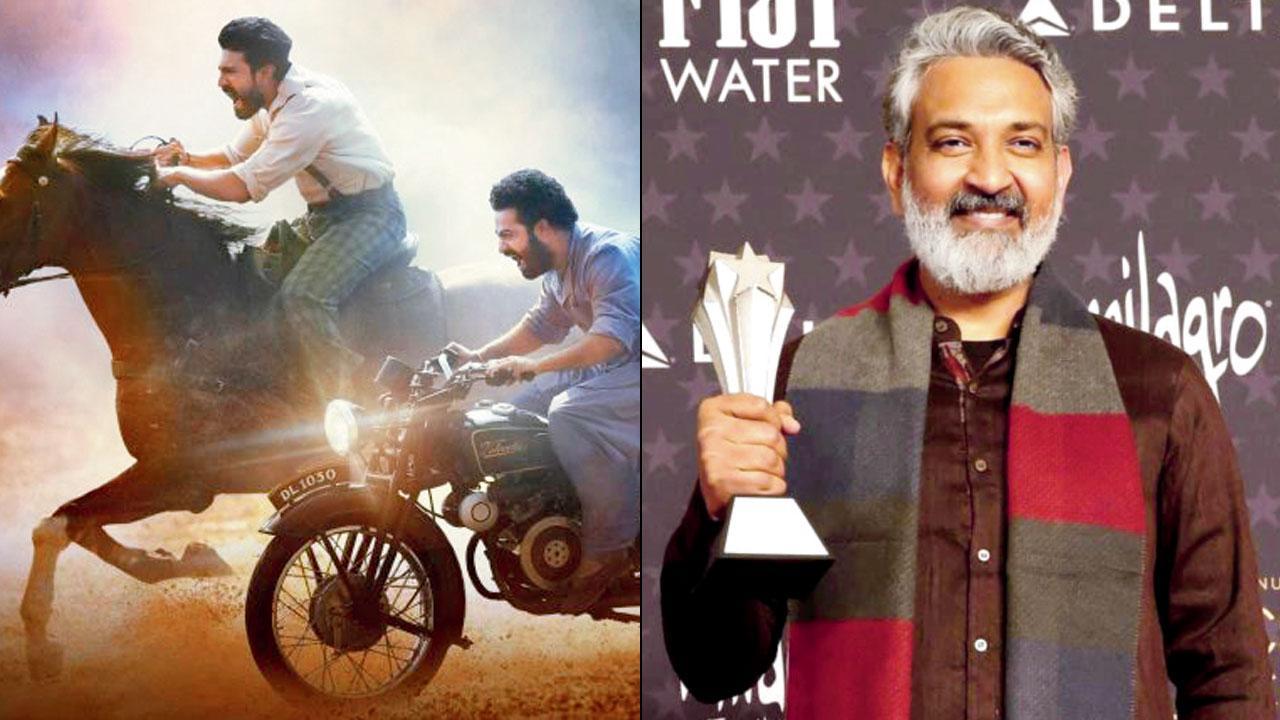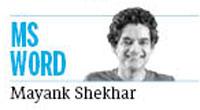Relooking at Rajamouli’s biggest moment for desis worldwide—because how can you not?

A still from the film RRR (right) director of the film, S S Rajamouli, with one of the two awards that the film won at the 28th Annual Critics’ Choice Awards held in Los Angeles
 Why wish for the hero, driven by morals/purpose, to have any flaws at all?” Screenwriter of S S Rajamouli’s RRR, Vijayendra Prasad, posed this to a live audience, before whom I was interviewing him once. He was referring to how western critics, tired of realistically imperfect portrayals of their leading men/women, even super-heroes, had embraced this “unapologetic heroism” in RRR, first.
Why wish for the hero, driven by morals/purpose, to have any flaws at all?” Screenwriter of S S Rajamouli’s RRR, Vijayendra Prasad, posed this to a live audience, before whom I was interviewing him once. He was referring to how western critics, tired of realistically imperfect portrayals of their leading men/women, even super-heroes, had embraced this “unapologetic heroism” in RRR, first.
Which could explain the film’s roaring, absolutely unprecedented appeal among lay audiences in the West (America), Far-East (Japan)? At least I’ve heard the film’s refreshing “lack of cynicism” often cited as reason enough. It helps that the desi/foreign heroes display as much a Jackie Chan-like fortitude on screen, as against an over-confident swag of the Rock, if you may.
There is also, of course, the usual Internet-effect of everything—chiefly water finding its levels, no matter where in the world. And we will progressively experience more and more of this intermingling, and multicultural ‘tipping points’.
Randomly, online is how China/Turkey discovered 3 Idiots (2009)—setting off a craze for Aamir Khan’s movies, with Dangal’s deadly pull thereafter. This wasn’t possible before.
Also Read: SS Rajamouli shares picture with James Cameron; says he analysed 'RRR' with him
A genuine, female craze for Shah Rukh Khan in Germany by the late Noughties, for instance, was thanks to their top TV network condescending to K3G (2001) for an afternoon show once. Mainstream audiences were, in fact, drawn to an ‘unapologetically emotional hero’ this time, who didn’t mind breaking into tears even—the expressive opposite of German men in life, let alone movies.
You notice how I’m mixing in RRR, with Dangal, with K3G, as if they were the same thing, while Bollywood (Hindi/Bombay) is different from Tollywood (Telugu/Hyderabad), isn’t it? It’s really popular Indian cinema.
We don’t have a better brand-name for it. Bollywood itself as a possible pejorative got coined sometime in the ’80s, when mainstream Telugu pix, getting copied/remade into Hindi flicks, was the norm (and vice versa).
The film that Vijayendra Prasad watches each time, before starting a new script, including RRR, is Sholay (1975), by the way, which is the kind of three-hour-plus, song & dance bromance the algo is likely to throw up, if you’ve watched RRR on Netflix.
First time on, even I saw RRR as the great Manmohan Desai (1937-94) pulling off, say, Dharam Veer (1977)—playing with more modern toys/tech, with a leap of faith, so over the top of anything you’ll imagine for a period movie!
So, there, sometimes I can’t tell between Tollywood and Bollywood—‘Lucknow/Hyderabad’ makes even less difference to someone who’s never tried biryani before, namely non-desis.
Which is to take away nothing from either filmmaking tradition/history. And that Indians themselves could do with experiencing more Indian cinema—an access/exposure that OTT platforms have finally made possible.
I watched K V Reddy’s classic Mayabazar (1957), only intrigued by how highly both Prasad and Rajamouli recommend the film as textbook Telugu cinema.
It’s based on a subplot of Mahabharat, centred on Abhimanyu, Lakshmana, Savitri, Ghatotkach (children of Arjun, Duryodhan, Balram, Bheem). Few minutes into this movie, and you can sense the original visual-template for Indian television’s Ramayan and Mahabharat (of late 1980s)—down to weapons/arrows kissing in the sky, from opposite directions, one of which disappears, much to the frown on the loser, who shot it!
Also, Prasad and Rajamouli publicly owe their storytelling to the two Indian epics; which became problematic for the better-informed, who saw in RRR a cultural appropriation of the Gond tribal hero, Bheem (NTR Jr), who’s seemingly saved/civilised by a brother from another mother, the upper-caste Hindu, Raju (Ram Charan) who, in turn, morphs into an image of Lord Ram in the final act!
RRR, set in 1920, is about two revolutionaries fighting against British colonialists, bloodsucking villains, basically. This is punching up, of course. Still hard to see how white, male fans have not once called out this caricature. Must be the white man’s guilt, acting against what was once the despicable ‘white man’s burden’?
Maybe, but it’s unimportant. Where RRR comes from is—a lot of money, to make it look and feel the way no Indian movie has. Upping levels with each set-piece, choreographed by the majestically named King Solomon, that’s taken months to execute. This is because Rajamouli got to make and deliver Baahubali before this—a huge step-up from Magadheera, that blooded him to box-office in the first place.
Prasad tells me Rajamouli kept breaching Baahubali’s budget—eventually by a huge percentage of the planned investment that could secure a return, given the film’s established (Tollywood) leads. Producer Shobu Yarlagadda, Prasad recalls, didn’t complain. Knowing that if he cut back instead, whatever had been spent would go waste too—much rather expensive, than an unrealised dream. Trust was complete. Baahubali delivered beyond public imagination. RRR followed. Producers Yarlagadda, Prasad Devineni were unsung stars.
Speaking of dreams, Prasad’s elder brother Siva Shakthi Datta, an artistic polymath, always wanted to make a film. Their agricultural family betted on Datta’s debut. The film got shelved mid-way. The family became bankrupt.
Decades later, Datta’s melodic musician son, M M Keeravani (M M Kreem in Bollywood) became the first Indian to win Golden Globes for RRR, written by Datta’s brother Prasad, directed by nephew Rajamouli. Everyone’s discussing if RRR is India’s ‘Crouching Tiger Hidden Dragon’ global moment. Keeravani’s song ‘Naatu naatu’ is currently our Despacito!
Mayank Shekhar attempts to make sense of mass culture. He tweets @mayankw14
Send your feedback to mailbag@mid-day.com
The views expressed in this column are the individual’s and don’t represent those of the paper.
 Subscribe today by clicking the link and stay updated with the latest news!" Click here!
Subscribe today by clicking the link and stay updated with the latest news!" Click here!










